The best varieties of ampel petunias and features of their cultivation
Ampel petunia is a popular and easy-to-maintain ornamental plant that is used to decorate personal plots and balconies. It has cascading shoots, densely covered with small but bright flowers. Due to its shape and abundance of flowering, petunia looks aesthetically pleasing both in flower beds and in pots.
There is a huge variety of varieties of this plant. They differ in the size and color of the inflorescences, the length of the shoots, the foliage of the bush. What varieties of petunias are most popular and what is their feature, read on.
The content of the article
What is ampelous petunia
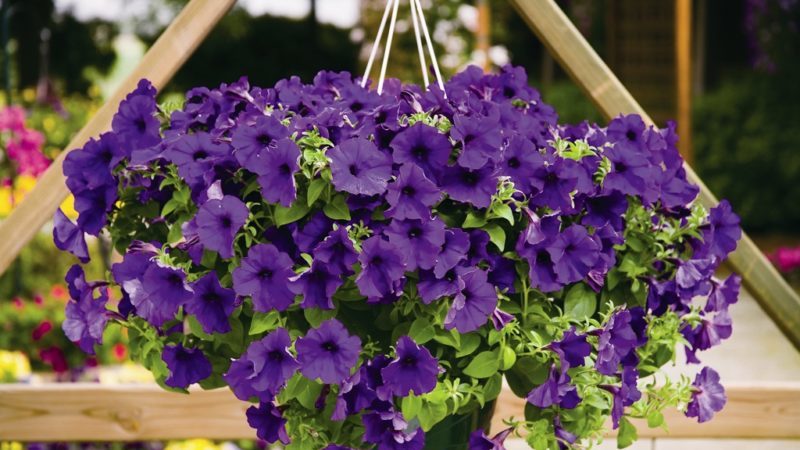
Ampel petunia is an ornamental plant that is used to decorate flower beds and balconies. To understand how it differs from other varieties of such colors, consider its main characteristics:
- Bush and shoots. Sprawling bushes. They have many shoots. The length of the stems varies between 30-120 cm. The stems are thin and fall in one direction.
- Flowers. They are bell-shaped and relatively small in size. There are a variety of shades, and they are always lighter outside than inside. Some specimens have a pattern or border of excellent color around the edge of the petals. The plant produces many flowers that form in the axils of each shoot.
- Leaves. The size depends on the age, the older the plant, the larger the leaf blade. The leaves are oval-rounded, pointed on both sides. Covered with light pubescence, making them soft to the touch.
Ampelous and cascading petunias are similar. The latter have more powerful and long stems, which are raised at the root and split in different directions. They have larger inflorescences, but flowering is less abundant. Ampel shoots grow downward, and cascading, first upward, then on the sides, and only then downward.
It is interesting! Botanists have established that cascading petunia is a type of ampelous.
Popular varieties of ampel petunias

There are many varieties of petunias on the market. They differ in the size and color of the inflorescences, the length of the shoots, as well as resistance to negative environmental factors.
All varieties are divided into large-flowered and small-flowered (multi-flowered). The former are distinguished by inflorescences with a diameter of 8 cm, and the latter have inflorescences 5-7 cm in size. Small-flowered petunias usually have more abundant flowering than large-flowered ones, but in both cases the plants are almost completely covered with inflorescences.
It is believed that the care and cultivation of petunias with large flowers is more difficult than with small ones. The fact is that with prolonged torrential rains, inflorescences with a diameter of more than 8 cm fall off. Therefore, many gardeners grow such varieties only in pots.
It is interesting! Mini-flowered petunia appeared in the markets. The size of its flowers varies between 2.5-4 cm.
Corduroy F1
Corduroy is a hybrid petunia variety. It belongs to the small-flowered type.
The maximum length of the shoots reaches 100 cm, and the minimum is 80 cm.
The advantages of the Velvet variety include: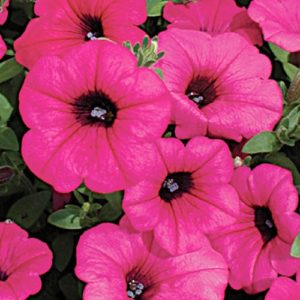
- low price of planting material;
- immunity to major diseases;
- resistance to pests;
- fast growth;
- high germination of planting material;
- the possibility of seed reproduction.
This series includes several cultures. These include:
- Parple Velvet. Shoots reach a length of 100 cm.The diameter of the flowers varies within 5-6 cm. The color is deep purple, with a dark (almost black) pharynx.
- Salamon Shades Velvet. The length of the cascade reaches 80 cm. The diameter of the flowers is 7-8 cm. They have a pastel orange-pink (salmon) shade.
- Rose Wayne Velvet. The length of the shoots is equal to 100 cm. The petals are distinguished by a light pink shade with a dark pink network of veins and vertical stripes of the same color. The diameter of the flowers is 5-5.5 cm.
- Rosie Velvet. The length of the branches reaches 80 cm. The bright pink flowers have a light yellow (beige) pharynx. Diameter from 6 to 7 cm.
Avalanche
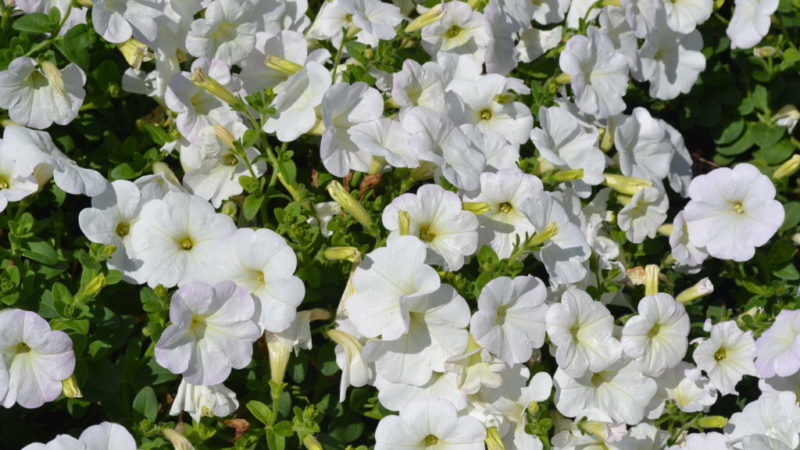
A series of petunia hybrids Avalanche is popular with gardeners. She earned the right to be called so thanks to the flowers, which are formed on the bush in such quantities that the hanging ampelous plant really resembles a colored avalanche.
The length of the shoots varies from 80 to 120 cm. Flowers have a diameter of 7 to 9 cm. This plant is often referred to as large-flowered.
The group is valued for:
- breeding possibility seeds;
- abundant flowering;
- unpretentiousness to weather conditions;
- variety of shades.
Several varieties belong to the group of ampelous petunias Avalanche. They differ in flower color:
- Red. A red petunia with a dirty purple throat and thin black lines down the center of each petal.
- White. It has white flowers with a yellow-green fawn.
- Salmon. The flowers are salmon-colored with a white throat.
- Pink. The petunia is bright pink with a white throat.
- Purple star. Inflorescences of a deep red shade with a pattern in the form of a star and a yellow throat.
- Purple. A dark pink petunia with a deep purple center.
- Yellow star. White at the edges, with a distinct bright yellow veining from the center, resembling a star.
- Blue Star. A purple-colored petunia with a white pattern reminiscent of a five-pointed star.
- Yellow whim. In cool weather, it has a cold lemon shade. At elevated temperatures and sunny weather, it acquires a pale pink tint.
Opera
 Petunia Opera is a group of first generation hybrids. Refers to small-flowered varieties. The length of the shoots is 80-120 cm. The diameter of each flower is 5-7 cm.
Petunia Opera is a group of first generation hybrids. Refers to small-flowered varieties. The length of the shoots is 80-120 cm. The diameter of each flower is 5-7 cm.
The main advantage is considered to be undemanding to lighting. The variety grows even in partial shade.
The Opera group includes:
- Raspberry ice. It has pale pink flowers with a crimson center and thin lines on the petals, reaching 6 cm in diameter. The length of the shoots is 1 m.
- White. White petunia with greenish pharynx. The length of the stems reaches 80 cm.
- Coral. It has coral inflorescences with ebb and a light yellow throat. The length of the shoots is 1.2 m.
- Red. Has a corresponding saturated shade. Differs in the largest of the series of flowers, reaching a diameter of 8 cm.
- Blue. A plant with bright purple buds.
- Parple. Has a muted pink color and black throat.
- Raspberry veins. White petals are covered with bright pink veins to the brim.
- Blue. It has blue double flowers.
- Purple. The pinkish petals have purple streaks.
- Pink. Pastel pink petals surround the white throat.
Success
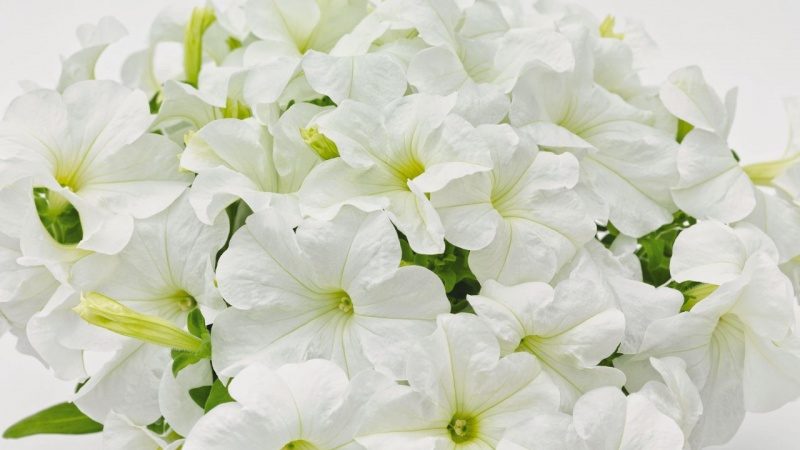
Petunia Success is a large-flowered plant. It features short shoots, the length of which varies from 30 to 70 cm.
Several varieties that are part of the Success group:
- Deep pink. Shoot length reaches 30-45 cm. It has large crimson flowers 10-12 cm in size.
- Burgundy. Dark crimson flowers with a diameter of 10-12 cm.The size of the stems is 35 cm.
- Silver Wayne. The shoots reach a length of only 30 cm.The flowers are light pink with purple veins, 6.5-8 cm in diameter.
Growing features
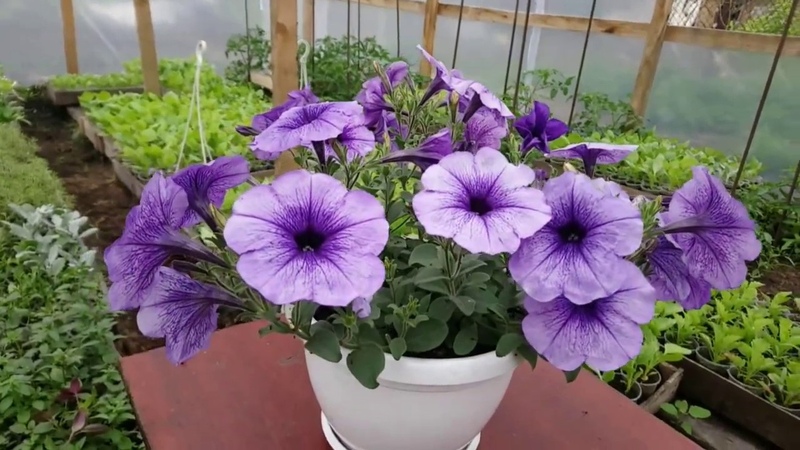
It is not difficult to grow ampelous petunia. This is an unpretentious plant that requires minimal maintenance.
Many novice gardeners think that all varieties of petunias have similar agricultural practices.
In fact, in order to grow ampelous petunia, it is important to consider several nuances:
- Distance between plants.It should not be less than 30 cm, while a gap of 20 cm is left between bush varieties.
- Lighting. Ampel petunia is especially demanding on lighting. If it is planted in a shaded area, it will bloom poorly.
- Formation. The ampelous variety requires more attention to formation than bush petunias. She not only pinch the main stem, but also cut off the lateral shoots. In this case, parts of the stems are precisely cut off, since pinching is ineffective.
- Pruning seed pods. In contrast to the cascade petunia, in the ampelous variety, it is necessary to cut off the faded fruits and boxes with seeds. Otherwise, few flowers will form.
Planting ampelous petunias and growing seedlings
Ampel petunia is propagated by vegetative and generative methods. In the first case, cuttings are used, and in the second, seeds.
Vegetative propagation is convenient to use when you want to breed a certain variety of petunias. The generative method is used for new series.
Note! Self-collected seeds do not always retain their parental characteristics, especially if a hybrid was used. Therefore, varietal petunias are recommended to be purchased from reliable seed producers.
For any growing method, the planting technology will be the same. Petunia is planted in holes 10x10 cm, without deepening the root collar. The distance between plants is 30 cm. After planting, the flowerbed is watered.
Seed method
Seeds are bought in a store or used independently harvested planting material. Typically, the manufacturer processes the product in the factory.
Homemade seeds require preparation before sowing:
- Disinfection. The seeds are soaked for 30-60 minutes. in a light pink solution of potassium permanganate. After that, they are washed under running water.
- Growth stimulation. During the day, the planting material is soaked in a growth stimulator, for example, "Epine".
The store sells granulated seeds, which are large in size, making them easy to sow. Loose leaves are cheaper and there are more in the package, but they are small, which makes seeding difficult.
Before sowing seeds, prepare a container (usually a large common box), drainage (expanded clay, artificial filler, broken ceramics) and soil. Buy special soil in the store or prepare it yourself from:
- 2 pieces of garden land;
- 2 parts of peat;
- 2 parts of humus;
- 1 part sand.
The soil, drainage and seed container are disinfected. Use a dark pink solution of potassium permanganate or boiling water.
A 1 cm layer of drainage is poured into the container, and the rest of the space is filled with soil so that 2-3 cm remain free to the edge.
If granulated seeds are used, then they are simply laid out on the ground at a distance of 1-2 cm from each other. Then they are pressed into the ground.
Seeds are mixed in bulk with a small amount of sand and spread in an even layer over the soil. Another option is to put snow on top of the ground, over which to distribute small dark seeds with tweezers or a toothpick.
Crops are moistened with warm water from a spray bottle. The container is covered with foil and removed to a warm place, moistening the soil as it dries.
After the appearance of the first shoots, petunias begin to air, gradually increasing the duration of the procedure. When 2 true leaves appear on the plants, the greenhouse is dismantled.
Seedlings are watered daily in the morning or evening. In some pots dive after the appearance of 2 true leaves.
note! Seeds for seedlings are sown in late February - early March.
Cutting method
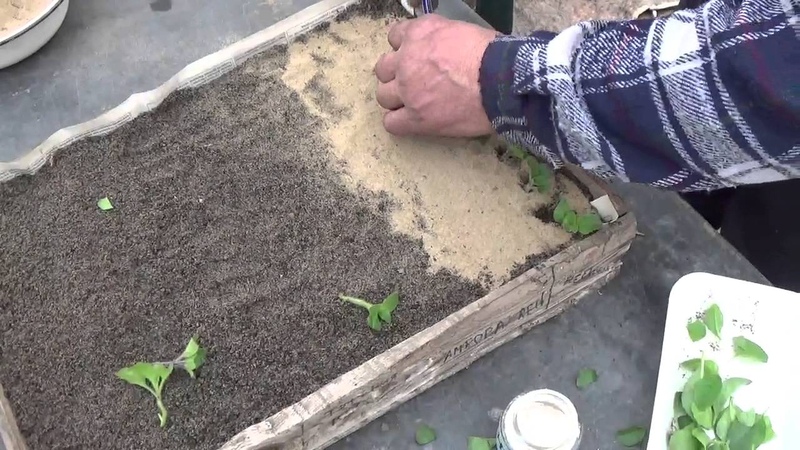
For propagation by cuttings you will need a healthy ampelous plant bush. Cuttings are cut from it at an angle, on which at least 2 internodes should remain.
The cut of the cuttings is immersed in a light pink solution of potassium permanganate for half an hour. Then it is placed in a rooting stimulator.
The soil mixture for the cuttings method is prepared the same as for seedlings. Some gardeners prefer to mix garden soil and hydrogel in equal proportions.
First, the cuttings are planted in a common container. They are buried so that they stand unsupported. Cover with a bag or film on top.
Rooting occurs in 1-2 weeks. After that, the seedlings are planted in individual plastic (preferably transparent) cups. A dive into a new container is carried out when the root system fills the old one.
Throughout the period cultivation seedlings are watered every day. The greenhouse is dismantled immediately after rooting.
Features of care for abundant flowering
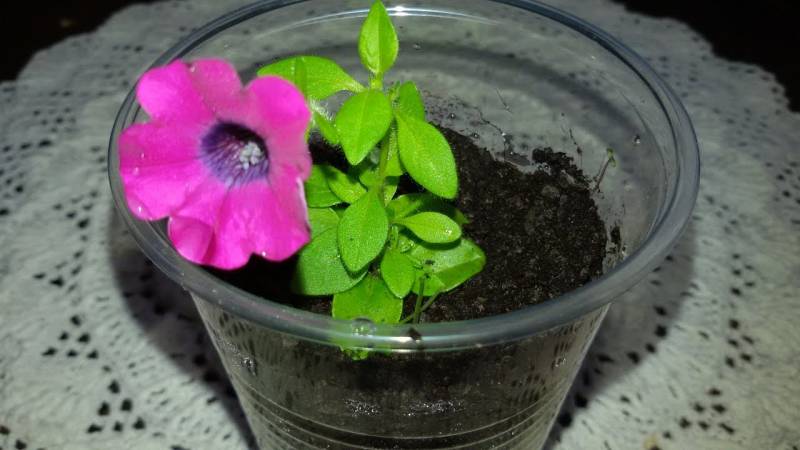
For petunia to bloom profusely, it needs to provide the right growth conditions. Plant care does not take much time.
How to care for ampelous petunia to have many flowers:
- Watering. Petunia is watered every day with warm water under the root. It is important that no water gets on the leaves. The procedure is carried out in the morning or in the evening. The older the plant, the more water is used on it.
- Top dressing. Once a week, petunias are fed with fertilizers containing large amounts of phosphorus and potassium. At the stage of growing seedlings, fertilizers are added to the water, using humates for the first week, and potassium salts for the second. Such intensive feeding is done before planting in a permanent place.
- Formation. Even at the stage of growing seedlings, when 3 pairs of real leaves appear, the top of the ampelous petunia is cut off in order to stimulate the formation of side shoots. To make the inflorescences larger, and they turn out to be large, at least 1 time a week, the shoots are cut to 60% of the length.
- Removing wilted flowers. Withered flowers and seed crusts are removed. They inhibit the development of new flowers and make the flowering less abundant.
Application in landscape design
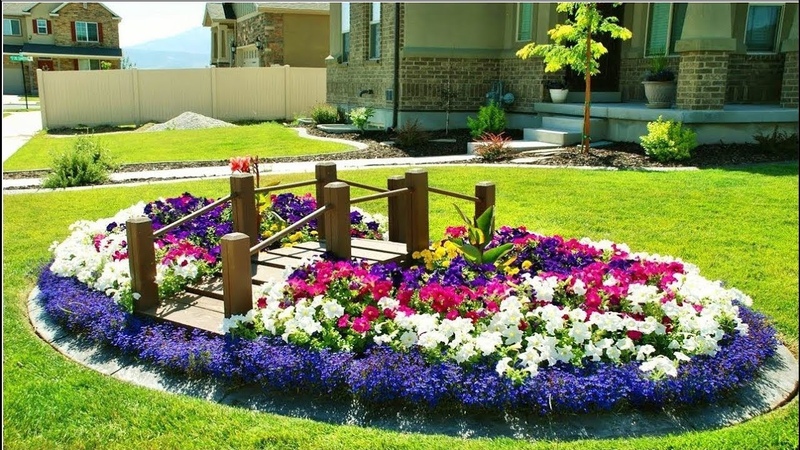
With the help of ampelous petunias, you will be able to create the most unusual compositions and make your fantasies come true. After all, this plant takes root well both in the garden and on the balcony.
Flowers in pots are hung out near the entrance to a house or a gazebo, placed around the site, suspended from trees. The ampelous petunia on the pillars, imitating a flowering tree, looks interesting.
In the open field, the plant is used to create alpine slides. A flower looks beautiful as a frame for a flower bed.
Conclusion
Ampel petunia looks advantageous in pots and in the open field. Many flowers are formed on its cascading shoots, which makes the plant look like a flower carpet. It is suitable for decorating a garden, balcony and windowsill.
Growing petunia is easy. The main thing is to apply top dressing in a timely manner, form the plant and moisten the soil. It doesn't take long, but it gives impressive results.